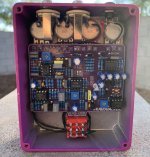blackhatboojum
Well-known member
- Build Rating
- 5.00 star(s)
Question... How many BF-2 flangers does a person need?
Answer... All of them!
If you don't know me by now, I'll let you in on a little secret... I love me some Boss flanger. In total, I've built 5 of them. 4 of them have been on the Fraudhacker PCB and 3 of those have been of the BF-2 variety. What makes this one different than those other BF-2's you may be wondering? Well, I used a NTE1641 BBD for this one. I wanted to know if there is a sonic difference between a MN3207 and a MN3007 in the same style of circuit and if I’m going to be honest... I'll use any excuse to add another BF-2 to my collection. Have I mentioned that I love Boss flangers yet ? In all seriousness though, I spent about 40 minutes contrasting and comparing this build with my OG Baron of Arizona flanger. I can honestly say, there's little to no difference between the sound of my MN3207 BF-2 and this one. This latest build has a slightly lower overall noise floor and the flange wasn't quite as deep with the depth knob maxed but, that was the only difference I could hear. Those two things could easily be chalked up to part tolerances so I'm not reading too much into it. Both sound exactly like a Boss BF-2 and I can dial them in to sound exactly the same. Outside of that, there's not much else I can say. Same color enclosure, same artwork, and I used white knobs instead of black for this one. That's pretty much it.
? In all seriousness though, I spent about 40 minutes contrasting and comparing this build with my OG Baron of Arizona flanger. I can honestly say, there's little to no difference between the sound of my MN3207 BF-2 and this one. This latest build has a slightly lower overall noise floor and the flange wasn't quite as deep with the depth knob maxed but, that was the only difference I could hear. Those two things could easily be chalked up to part tolerances so I'm not reading too much into it. Both sound exactly like a Boss BF-2 and I can dial them in to sound exactly the same. Outside of that, there's not much else I can say. Same color enclosure, same artwork, and I used white knobs instead of black for this one. That's pretty much it.


Answer... All of them!
If you don't know me by now, I'll let you in on a little secret... I love me some Boss flanger. In total, I've built 5 of them. 4 of them have been on the Fraudhacker PCB and 3 of those have been of the BF-2 variety. What makes this one different than those other BF-2's you may be wondering? Well, I used a NTE1641 BBD for this one. I wanted to know if there is a sonic difference between a MN3207 and a MN3007 in the same style of circuit and if I’m going to be honest... I'll use any excuse to add another BF-2 to my collection. Have I mentioned that I love Boss flangers yet


Last edited:


